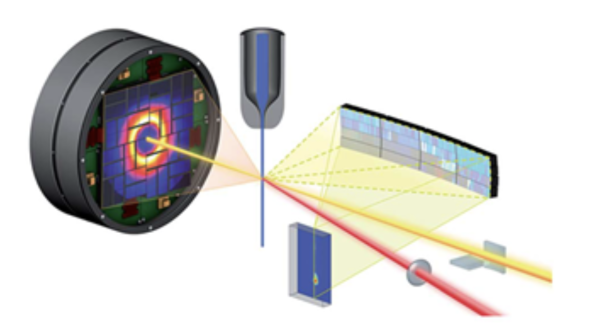Time-resolved X-ray Scattering
(See LCLS Instruments for further details and Standard Configurations for hard X-ray scattering and spectroscopy: XPP, XCS, MFX, CXI, MeV-UED)
X- ray diffraction (XRD) techniques provide atomic-scale structural information of periodic systems (crystalline) and X- ray scattering provides atomic to mesoscale structural information of non- periodic systems (solutions, non-crystalline).

Figure 1. Experimental schematic for time-resolved X-ray scattering and X-ray emission spectroscopy. 1
Figure 1 shows a typical pump-probe experimental set-up with a large area detector collecting for forward scattered X-rays, and Bragg crystals collecting the emitted X-rays, and imaging them onto a smaller detector for spectroscopy (see below).
Sample delivery can take many forms, including raster-scanned targets, droplets on tape, or liquid streams or jets of various forms.
The X-ray scattering signal ΔS(Q,t), arises from all structural dynamics induced by the excitation of the sample. In a typical analysis, the isotropic scattering signal is modeled as a sum of three contributions arising from changes in solute structure, changes in solvation cage structure, and changes in the bulk solvent structure:
ΔS(Q,t) = ΔSsolute(Q,t) + ΔSsolvatikon cage(Q,t) + ΔSbulk solvent(Q,t)
Each of these contributions can be further separated into specific molecular structural distortions and solvation processes. The scattering signal is analyzed by simulating the contribution from each of these contributions and comparing the sum of these to experiment.
Multi-modal ultrafast X-ray studies, combining hard X-ray scattering and X-ray spectroscopy have been pioneered at LCLS as a powerful approach to directly quantify the coupling between electronic and structural configurations in molecular complexes with atomic resolutions and spin-state specificity. As an example of the insight to molecular systems provided by the combination of X-ray scattering and spectroscopy see ref. [1].
K. S. Kjær, T. B. Van Driel, T. C. B. Harlang, et al., "Finding intersections between electronic excited state potential energy surfaces with simultaneous ultrafast X-ray scattering and spectroscopy", Chemical Science 10, 5749 (2019).
